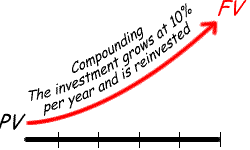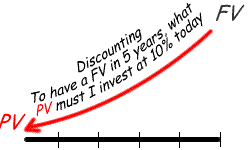|
The Basics
Discounting
Net Present Value
Terminal Value
Value Added
The Decisions
Discount Rate
Hurdle Rate
Weighted Average Cost of Capital
(WACC)
The Math
Estimate Terminal
Value
Annuity Method
Market Value/Sales
Compare Methods
DCF Key Questions
Combine Action Plans
Key Points
|
Compounding and discounting
"Compound interest - it is the greatest mathematical
discovery of all time"
Albert Einstein
 Compounding Compounding
You put money in an account today (its present value - PV)
for a promised rate of return (interest - INT) for a number of periods
(NPER - usually months or
years).
The interest received in reinvested at the end of each period - it compounds.
The future value (FV) is the value of the investment compounded at the
end of a given number of periods. We know the value of our initial investment
and the
interest rate, and can
calculate
the FV at the end of any
period.
Discounting
 It is the reverse of compounding. We know the how much we need on a
specific date in the future (FV) and calculate how much
we need to invest today, PV,
at an interest rate. Work from the future back to the present. It is the reverse of compounding. We know the how much we need on a
specific date in the future (FV) and calculate how much
we need to invest today, PV,
at an interest rate. Work from the future back to the present.
You can find Excel functions to make these calculations by searching
Excel's Help File for FV (compounding) or PV (discounting).

 The boss thinks about
The boss thinks about |
|
Discounted cash flow and net present value

|
|